Subtotal: $
Checkout-

Refugee Letters
-

Life in Zion
-

How to Run a Cemetery
-

Integrity and the Future of the Church
-

Daring to Follow the Call
-

Poem: “For the Celts”
-

Poem: “Wreathmaking”
-

Poem: “The Hunger Winter, 1944–5”
-

Editors’ Picks: The Cult of Smart
-

Editors’ Picks: The Utopians
-

Editors’ Picks: The Lincoln Highway
-

Casa de Paz
-

The Pilsdon Community
-

Letters from Readers
-

Nonexistence Does Not Scare Me
-

Toyohiko Kagawa
-

Covering the Cover: Beyond Borders
-

Choosing America
-

Church as Sanctuary and Shelter
-

Northern Ireland’s New Troubles
-

When Migrants Come Knocking
-

The Florentine Option
-

Three Kants and a Thousand Skulls
-

The End of Rage
-

Telling a Tale of Two Fathers (Video)
-

Home Is Not Just a Place
-

The Quest for Home
-

In Search of Lost Fig Trees

Child of the Stars
Le Petit Prince Lands in Bolivia
By River Claure and Coretta Thomson
October 21, 2021
Available languages: Español
Next Article:
Explore Other Articles:
River Claure is a Bolivian visual artist and creator of Warawar Wawa, a photography project that reimagines Antoine de Saint-Exupéry’s Le Petit Prince as an Aymara fairy tale. Plough’s Coretta Thomson caught up with him to find out the story behind it. She introduces their conversation:
In the art history courses I took at the University of Montevideo, our professors often spoke of transculturation, a term that anthropologist Fernando Ortiz used to describe the blending of several cultures to create something new. It’s a phenomenon that’s been glaringly obvious to me wherever I’ve traveled in Latin America. Unlike the European colonists of what is now the United States who displaced, erased, and replaced the First Nations, Castilian conquistadors generally took the helm of the pre-Columbian world order – often violently, and to their own profit – adding Christian and European elements to it. The legacy of these practices is certainly mixed, but mestizo art and architecture are among the most beautiful results.
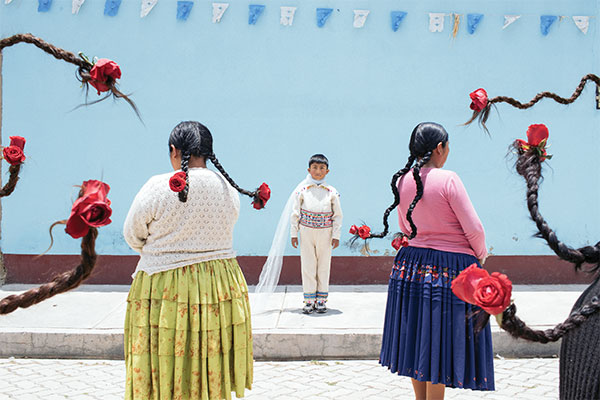
All photographs courtesy of River Claure
So I was intrigued to hear of a contemporary example of transculturation: Warawar Wawa, a reinterpretation of Antoine de Saint-Exupéry’s Le Petit Prince in a twenty-first-century Bolivian context, which illustrates the first Aymara version of this classic translated directly from the French. I spoke with its creator, River Claure, a photographer and Cochabamba native, on Zoom. An urbanite of both Aymara and Caucasian heritage, he read the novella for the first time on the Madrid metro, while studying visual arts. The text spoke to him but the blond protagonist in the illustrations was clearly created for a different context. How would an Andean Little Prince look, he wondered, and what characters would he meet on a journey through Latin America?
After returning to Bolivia, Claure completed several small projects to discover his style while securing support for the Le Petit Prince project. As he explained:
Today, we are all one big mix of cultures and races, but for some strange reason extremist discourses are dominant in many parts of the world. I, for one, do some things the Indigenous way – like wearing traditional sandals and chewing coca leaf – but I also watch Netflix and drink Coca-Cola. Sociologist Silvia Rivera Cusicanqui coined a term which I love: ch’ixi, loosely translated as “gray.” It refers to the Aymara weaving method used to make aguayo blankets: when one color is juxtaposed over another, a third, indeterminate hue is created. I believe we are all ch’ixi, and I strive to explore this reality in my work.
Eventually, the national government offered to finance Warawar Wawa. After a year of preparation, Claure and his team traveled through the Andes for a month, taking photographs. Claure reflects on the project, which was published last year:
Le Petit Prince is an adult book disguised as a children’s story; it touches deeply on themes like love, friendship, and death. It was a challenge to rethink these themes in a modern Bolivian setting. Although the Aymara culture was once very close to nature, the polarization of the last decades has changed things dramatically. Things are labeled as either Indigenous and rural, or urban and foreign, with a clear line between them. I attribute this to the centuries of mistreatment the Aymara suffered, a wound that was still fresh when the Indigenous came to power. Instead of cultivating the ancestral, nonviolent culture of the villages, a new sentiment emerged, one of getting back at the urbanites, Whites, and the children of immigrants.
So this project was not so much a reflection of modern Bolivia as an invitation to reconciliation. It has been very well received, which I think means that many people identify with it. I believe that using art to help people see themselves as ch’ixi, highlighting our similarities and equal worth, chips away at the barrier that has divided us for so long. Change will only come when we imagine and work for a better nation: living alongside each other, loving and embracing Indigenous culture but also the West’s positive contributions.
This interview, from December 8, 2020, was conducted and translated from the Spanish by Coretta Thomson.
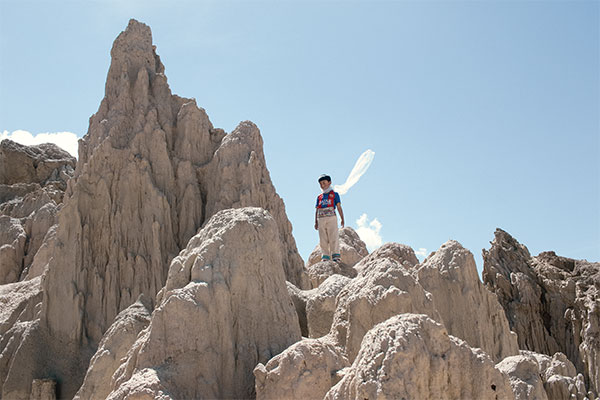
“The literal translation of petit prince in Aymara is pirincipitu wawa, meaning ‘baby prince.’ In speaking with the team of Native translators, however, we realized that there is no reference for monarchy in Aymara culture. So we went for an interesting word: warawar, which refers to a constellation, a group of lakes in the Andes, or a group of mountains; in sum, a group of superior beings. So Warawar Wawa means ‘child who descended from something magical and fantastic.’”
From Le Petit Prince: “What makes the desert beautiful,” the little prince said, “is that it hides a well somewhere …”
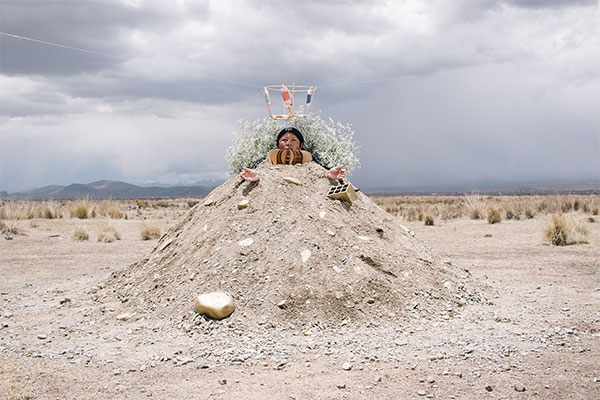
“The King is reimagined as a Virgin of the Mountain of Potosí, a seventeenth-century baroque icon. I consider both King and Virgin to be figures of power in the Spanish culture that conquered the Americas. It also gives a nod to mestizo art and transculturation: she’s a Pachamama – the Mother Earth the Aymaras venerated – with foreign features. We placed shiny stones on the slopes of the mound to represent the gold and silver that has been extracted from Cerro Potosí over almost five hundred years. Bricks are included because Bolivia’s industry was born here too: the first railroad and coal-fired machinery in the country were used at these mines. The queen’s head is ringed with fireworks that are often used in Aymara festivals today, like a golden crown for the Virgin.”
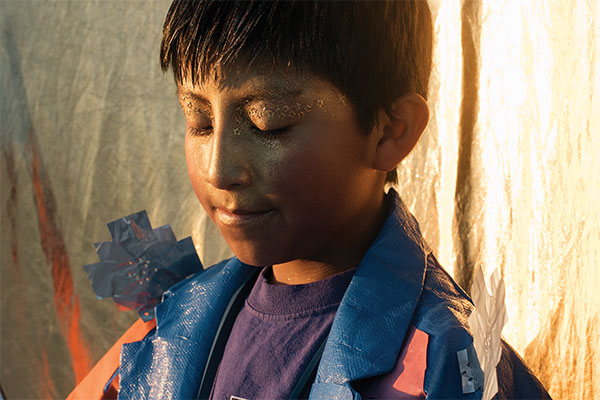
“Instead of professional actors, I like to hire local people from the communities where I do the photo shoots. But we did do a casting call for the Little Prince himself. It was in El Alto, on the outskirts of La Paz, and hundreds of boys came; a few girls even showed up! Finally, we chose this young boy of Aymara descent. We traveled with him and his mother all over the Andes for a month, and became very close. We read the original Le Petit Prince together and planned the takes as a team; it was very beautiful and collaborative.”
From Le Petit Prince: “Only the children know what they are looking for,” said the little prince. “They spend their time on a rag doll and it becomes very important, and if it’s taken away from them, they cry … ”
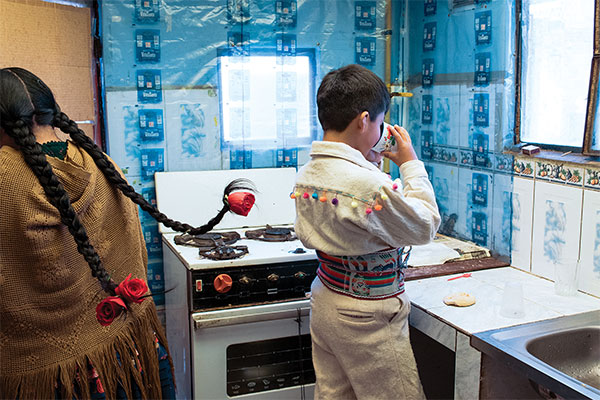
“The rose is the character I had the hardest time to conceptualize, but I’m happy with the result. Some literary critics consider her a symbol of sexual awakening, but for me, the rose is a motherly figure. After all, the first woman a child loves is his mother! And if you invert the image of a woman in a skirt, her dress looks like an open flower. So here you see a cholita, a traditional woman boxer, portraying the rose that defends herself with her thorns. But she is also an important part of the child’s world, an object of his love. At one point in the story the prince realizes that there are many other roses besides his mother, but she is still the most beautiful one in his eyes.”
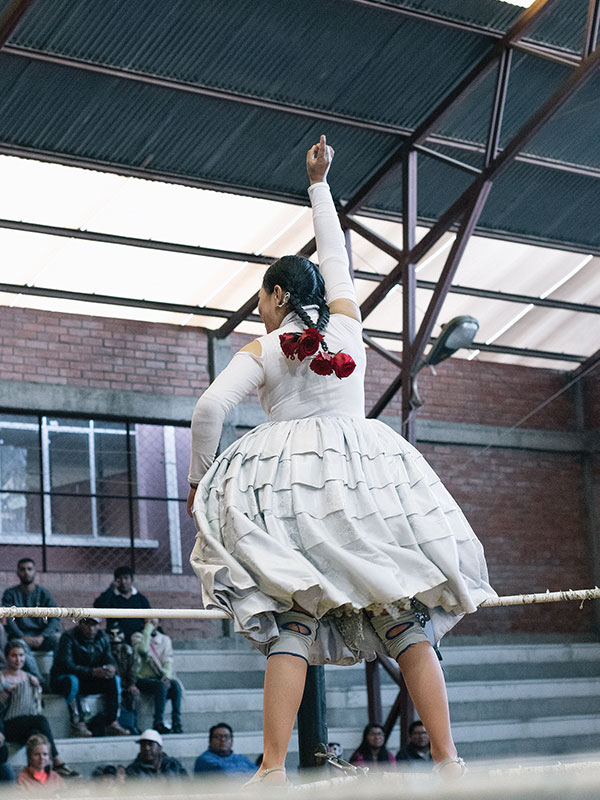
From Le Petit Prince: “My flower is ephemeral,” the little prince said to himself, “and she has only four thorns with which to defend herself against the world! And I’ve left her all alone where I live!”
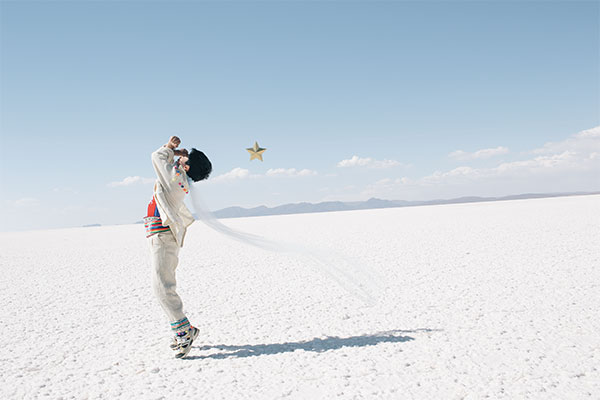
For more on River Claure’s Warawar Wawa project, see the artist’s website at riverclaure.com.
Excerpts from Antoine de Saint Exupéry, The Little Prince, trans. Richard Howard (Mariner Books, Houghton Mifflin Harcourt, 2000). Used by permission.
Already a subscriber? Sign in
Try 3 months of unlimited access. Start your FREE TRIAL today. Cancel anytime.








































Bro Lindsay
Thank you for sharing a most exciting adventure of writing and photography regarding Le Petit Prince. Really very exciting material and indeed I am sure the full text will engender much involvement and interest of new audiences. The original storyteller himself had a most varied life, in times that few of us could imagine. My aim is to forward this email to family in Alsace whose South American connection is in Colombia. In southern France, people also often learn Spanish in addition to English; in the north east, German. Wondering whether there may be ever an intention to translate into French where the interest would probably be very much aroused.
Elizabeth M Claman
This is all so lovely and interesting! Le Petit Prince has long been one of my favorite books. I love the way its timeless and deeply sensitive narrative is being re-imagined so beautifully in Bolivia.